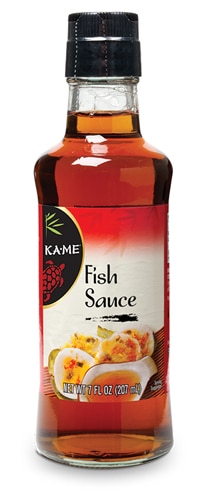KA-ME Fish Sauce Description
The Key to Asian Made Easy.™
KA•ME Fish Sauce is an indispensable seasoning utilized in kitchens throughout Southeast Asia. It is used much in the same way soy sauce would be used in China or Japan.
*These statements have not been evaluated by the Food and Drug Administration. This product is not intended to diagnose, treat, cure, or prevent any disease.
Nutrition Facts
Serving Size: 1 Tsp. (5 mL)
Servings per Container: About 41
| Amount Per Serving | % Daily Value |
|
| Calories | 0 | |
|
| Total Fat | 0 g | 0% |
|
| Saturated Fat | 0 g | 0% |
|
| Trans Fat | 0 g | |
|
| Cholesterol | 0 mg | 0% |
|
| Sodium | 530 mg | 23% |
|
| Total Carbohydrate | 0 g | 0% |
|
| Fiber | 0 g | 0% |
|
| Total Sugars (Incl. 0g Added Sugars, 0% DV) | 0 g | |
|
| Protein | 0 g | |
|
| Vitamin D | 0 mcg | 0% |
|
| Calcium | 2 mg | 0% |
|
| Iron | 0 mg | 0% |
|
| Potassium | 10 mg | 0% |
|
Other Ingredients: Anchovies extract, salt, cane sugar.
Contains: Fish (anchovies).
Produced in a facility that processes milk, shellfish, soy, wheat and peanuts.
The product you receive may contain additional details or differ from what is shown on this page, or the product may have additional information revealed by partially peeling back the label. We recommend you reference the complete information included with your product before consumption and do not rely solely on the details shown on this page. For more information, please see our
full disclaimer.
Reviews
View printable version
Print Page
Sesame Salmon Noodle Bowl With Pickled Cucumbers
[vc_row][vc_column][vc_column_text]Light, fresh, and packed with flavor, this Asian salmon noodle bowl is a satisfying way to enjoy noodles while keeping it low-carb. Made with
Miracle Noodle konjac noodles, this dish delivers all the slurp-worthy goodness without the carbs, pairing perfectly with tender sesame-crusted salmon, charred veggies and tangy pickled cucumbers. A bright squeeze of lime and fresh mint take it to the next level – ready in no time for a nourishing meal!

Sesame Salmon Noodle Bowl With Pickled Cucumbers

Pickled Cucumbers
- 2 Persian cucumbers (sliced)
- 1 tsp. unsweetened rice vinegar
- 1 tsp. chili sauce
- 1/2 tsp. salt
Noodle Bowl
- 1 pkg. Miracle Noodle Spaghetti-Style Organic Konjac Noodles (rinsed)
- 1 salmon filet (cut in bite-sized pieces)
- 1/4 tsp. garlic granules
- 1/4 tsp. onion granules
- Sriracha hot sauce
- Sesame seeds
- 1 cup zucchini (cubed)
- 1/2 cup corn
- 1/4 tsp. salt (or to taste)
- 1 Tbsp. coconut aminos
- 1 tsp. fish sauce
- 1/4 lime (juiced)
- Fresh mint leaves (garnish)
- In medium bowl, combine cucumbers, rice vinegar, chili sauce and salt. Set aside to use in last step to serve.
- In small mixing bowl, place salmon cubes and sprinkle with garlic granules, onion granules, sriracha and sesame seeds.
- In sauté pan, spray avocado oil and sauté zucchini and corn until nicely charred.
- Move vegetables aside in pan and add salmon; sear on all sides 3-4 minutes.
- In microwaveable bowl, add rinsed noodles and microwave a few seconds, or put rinsed noodles in boiling water for 2 minutes, then dry noodles by placing in non-oiled pan on medium heat until dry.
- In serving bowl, place noodles, add coconut aminos, fish sauce, lime juice, salt and sautéed vegetables and toss together.
- Serve with sesame salmon, pickled cucumbers and fresh mint.
Your ingredients are waiting – shop now at Vitacost.

[/vc_column_text][/vc_column][/vc_row][vc_row][vc_column][vc_text_separator title="Featured Products" border_width="2"][vc_row_inner equal_height="yes" content_placement="middle" gap="35"][vc_column_inner width="1/3"][vc_single_image image="182937" img_size="full" alignment="center" onclick="custom_link" img_link_target="_blank" css=".vc_custom_1741707270333{padding-right: 7% !important;padding-left: 7% !important;}" link="https://www.vitacost.com/miracle-noodle-spaghetti-style-noodles-organic-plant-based"][/vc_column_inner][vc_column_inner width="1/3"][vc_single_image image="182936" img_size="full" alignment="center" onclick="custom_link" img_link_target="_blank" css=".vc_custom_1741707301252{padding-right: 7% !important;padding-left: 7% !important;}" link="https://www.vitacost.com/yellowbird-hot-sauce-organic-sriracha"][/vc_column_inner][vc_column_inner width="1/3"][vc_single_image image="182935" img_size="full" alignment="center" onclick="custom_link" img_link_target="_blank" css=".vc_custom_1741707323572{padding-right: 7% !important;padding-left: 7% !important;}" link="https://www.vitacost.com/coconut-secret-coconut-aminos-seasoning-sauce-marinade-soy-free"][/vc_column_inner][/vc_row_inner][/vc_column][/vc_row]






